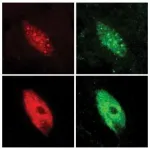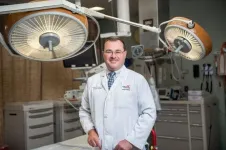(Press-News.org) LA JOLLA--(June 30, 2021) Scientists--and gardeners--have long known that plants grow taller and flower sooner when they are shaded by close-growing neighbors. Now, for the first time, researchers at the Salk Institute have shown the detailed inner workings of this process.
The study, published June 17, 2021, in Nature Genetics, offers a new understanding of how gene activity directs plant growth, and how quickly plants respond to their environment--with shifting light conditions triggering molecular changes in as little as five minutes. The findings provide insights into how to increase yield and safeguard world food production as climate change shrinks the planet's arable land.
"This paper shows, in high resolution, how plants respond to subtle environmental changes on the cellular level," says co-corresponding author Joanne Chory, director of Salk's Plant Molecular and Cellular Biology Laboratory, Howard Hughes Medical Institute investigator, and holder of the Howard H. and Maryam R. Newman Chair in Plant Biology. "Work that reveals how plants can adapt to greater environmental stresses will be critical as the effects of climate change intensify."
Plants in the shade grow faster and taller in an effort to break through the canopy and reach more light. At the same time, shaded growing conditions cause them to flower and produce seeds earlier than normal, in order to out-compete other plants. These responses might be helpful to wildflowers growing in a meadow, but on farms they can reduce production and result in bitter, low-quality crops--as any gardener whose lettuce has bolted knows.
In the new study, researchers looked at the role of specific transcription factors in activating this growth response. Transcription factors are proteins that turn genes on or off by binding to DNA.
The team worked with mutant seedlings lacking transcription factors called PIFs (PHYTOCHROME-INTERACTING FACTORs). When they grew these plants in an environment that simulated shade, the plants without certain PIFs did not elongate or speed up their growth, but instead continued to grow normally as if they were in full sunlight. Previously, the Chory lab showed that PIF7 plays the most important role in regulating shade-induced growth.
The researchers then took a closer look at the role of histones in this process, in particular the histone variant H2A.Z. Histones are proteins that act like spools for strands of DNA. When histones are exchanged or modified, they can work to activate or suppress certain genes.
The scientists found that canopy shade led to the removal of the histone H2A.Z at growth-regulating genes through the DNA binding of PIF7, which in turn activated their expression.
By using very short time intervals for their experiments, the researchers found that PIF7 gets activated, binds its target genes, and initiates the removal of H2A.Z, all within the first 5 minutes of the plant experiencing canopy shade.
"Our study describes another step towards a mechanistic understanding of how plants alter their gene expression in response to a changing environment," says co-corresponding author Joseph Ecker, a Howard Hughes Medical Institute investigator and professor in Salk's Genomic Analysis Laboratory.
Previous studies had identified PIFs and H2A.Z as having important roles in the responses of plants exposed to high temperatures; however, the timing of events was not known, notes co-author Björn Willige, a Howard Hughes Medical Institute research specialist in the Chory lab.
"Our study reveals the mechanism in close detail and also shows the rapid nature of the response. We found that when PIF7 is active, it binds to DNA. And our data indicate that this leads to the removal of H2A.Z from the DNA. Subsequently, genes are activated, and then this induces growth, to outcompete the neighboring plants," Willige says.
The speed of the process was unexpected, says co-author Mark Zander, an assistant professor at the Waksman Institute of Microbiology at Rutgers University. He noted that, in addition to triggering the stress response within five minutes, the histone landscape also recovered quickly when shade was removed.
"When we removed shade, the levels of H2A.Z at PIF7 target genes went back to normal within 30 minutes," he says. "I was surprised by how dynamic the process is, which is really the foundation for the elegance of our study."
PIFs play significant roles in the growth, development and pest defense of plants. Therefore, the team hopes that their findings can be translated to other plant responses that are important for farmers, especially in relation to helping plants be more resilient to climate change. The Salk Institute's Harnessing Plants Initiative seeks to help solve climate change by optimizing plants' natural ability to capture and store carbon.
INFORMATION:
Other authors on the study were Chan Yul Yoo of Oklahoma State University; Amy Phan, Renee M. Garza, Shelly A. Trigg, Yupeng He, Joseph Nery, and Huaming Chen of Salk; and Meng Chen of University of California, Riverside.
The research was supported by the National Science Foundation, the U.S. Department of Energy, the Gordon and Betty Moore Foundation, the National Institutes of Health, the Howard Hughes Medical Institute, the European Molecular Biology Organization, the Human Frontier Science Program and Deutsche Forschungsgemeinschaft.
About the Salk Institute for Biological Studies:
Every cure has a starting point. The Salk Institute embodies Jonas Salk's mission to dare to make dreams into reality. Its internationally renowned and award-winning scientists explore the very foundations of life, seeking new understandings in neuroscience, genetics, immunology, plant biology and more. The Institute is an independent nonprofit organization and architectural landmark: small by choice, intimate by nature and fearless in the face of any challenge. Be it cancer or Alzheimer's, aging or diabetes, Salk is where cures begin. Learn more at: salk.edu.
When it comes to defense, the body relies on attack thanks to the lymphatic and immune systems. The immune system is like the body's own personal police force as it hunts down and eliminates pathogenic villains.
"The body's immune system is very good at identifying cells that are acting strangely. These include cells that could develop into tumors or cancer in the future," says Federica Eduati from the department of Biomedical Engineering at TU/e. "Once detected, the immune system strikes and kills the cells."
Stopping the attack
But it's not always so straightforward as tumor cells can develop ways to hide themselves from the immune system.
"Unfortunately, tumor cells can block the ...
Growing resistance to our go-to antibiotics is one of the biggest threats the world faces. As common bacteria like strep and salmonella become resistant to medications, what used to be easily treatable infections can now pose difficult medical challenges.
New research from the University of Georgia shows that there may be more antimicrobial-resistant salmonella in our food animals than scientists previously thought.
Using technology she developed, UGA researcher Nikki Shariat and Amy Siceloff, a first-year doctoral student in UGA's Department of Microbiology, found that traditional culturing methods used to test livestock for problematic bacteria often miss drug-resistant ...
Since the onset of the COVID-19 pandemic last year, medical experts have stressed the importance of having a plan in the event of a positive test result. Where should you self-isolate? Do you have personal protective equipment for family members? Who should you notify about your diagnosis? An overwhelming 96% of healthy, educated adults surveyed by University of Houston researchers in the early stages of the pandemic did not have a comprehensive plan in mind, while 62% didn't have a plan at all.
"What that suggests is that it was difficult even for very high functioning people to digest and use all the complex information that was quickly emerging about ...
Following the first wave of SARS-CoV-2 infections in spring 2020, Europe experienced a resurgence of the virus starting late summer. Although it appears clear that travel had a significant impact on the circulation of the virus, it remains challenging to assess how it may have restructured and reignited the epidemic in the different European countries.
In a new study published in the journal Nature this June 30th, 2021, Philippe Lemey - Rega Institute, KU Leuven, Simon Dellicour - SpELL, Spatial Epidemiology Lab, Université Libre de Bruxelles, and their collaborators, built a phylogeographic model to assess how newly introduced viral lineages, as opposed to ...
Levelling up access to finance so that poorer countries can afford the funds needed to switch to renewable energy could see regions like Africa reaching net zero emissions a decade earlier, according to a study led by UCL researchers.
Access to finance (credit) is vital for the green energy transition needed to reduce global greenhouse gas emissions, as laid out in the Paris Agreement. But access to low-cost finance is uneven, with the cost of securing capital to help reach net zero differing substantially between regions.
Modelling created for the study, Higher cost of finance exacerbates a climate investment trap in developing economies, published in Nature Communications, ...
HOUSTON - The University of Texas MD Anderson Cancer Center's Research Highlights provides a glimpse into recently published studies in basic, translational and clinical cancer research from MD Anderson experts. Current advances include expanded use of a targeted therapy for a new group of patients with leukemia, molecular studies yielding novel cancer therapeutic targets, insights into radiation therapy resistance and a community intervention to reduce cervical cancer rates.
Using acalabrutinib as initial treatment for chronic lymphocytic leukemia
Chronic lymphocytic leukemia (CLL) is a cancer that occurs in the blood, bone marrow, lymph nodes, liver and spleen. It is the most common leukemia in adults, and while there are treatments ...
Heart attack, medically known as myocardial infarction (MI), is a common heart condition. MI is caused by problems in blood supply to parts of the heart. In severe cases, MI could be accompanied by ruptures in the wall separating different parts of the heart, such as in the ventricular septum (a wall that separates the right ventricle that pumps deoxygenated blood to the lungs for oxygenation, from the left ventricle that pumps oxygenated blood to rest of the body). Not surprisingly, without appropriate surgical intervention, a VSR due to MI increases the chances of death.
Current surgical techniques ...
Bioplastics -- biodegradable plastics made from biological substances rather than petroleum -- can be created in a more economical and environmentally friendly way from the byproducts of corn stubble, grasses and mesquite agricultural production, according to a new study by a Texas A&M AgriLife Research scientist.
green tractor pulling a red cart through a field of bioenergy sorghum that is taller than the tractor
A bioenergy sorghum crop is harvested near College Station. (Texas A&M AgriLife photo)
This new approach involves a "plug-in" preconditioning process, a simple adjustment for biofuel refineries, said Joshua Yuan, Ph.D., AgriLife Research scientist, ...
Dinosaurs roamed the Earth more than 65 million years ago, and paleontologists and amateur fossil hunters are still unearthing traces of them today. The minerals in fossilized eggs and shell fragments provide snapshots into these creatures' early lives, as well as their fossilization processes. Now, researchers reporting in ACS Earth and Space Chemistry have analyzed the molecular makeup of fossilized dinosaur eggshells from Mexico, finding nine amino acids and evidence of ancient protein structures.
Current research indicates that all dinosaurs laid eggs, though most haven't survived the test of time. And because whole eggs and shell fragments are very rare fossils, their mineral composition ...
Newly published research shows that a screening program in the University of Cincinnati Medical Center Emergency Department helped detect an outbreak of HIV among persons who inject drugs in Hamilton County, Ohio, from 2014-18.
The study was published in PLOS ONE.
The results of the study highlight UC contributions to public health surveillance as yet another reason why emergency departments should be screening for undiagnosed HIV infections, according to Michael Lyons, MD, associate professor in the Department of Emergency Medicine at the UC College of ...



